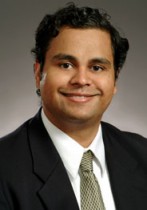Dr. Asthagiri is a research professor at the University of Florida’s Chemical Engineering department. His work focuses on the simulation of novel materials from an atomistic level. He uses a range of methods to scale from highly accurate quantum mechanics-based methods that probe 10-100 atoms up to simulations involving thousands of atoms based on parameterized potential models. This multi-scale modeling approach links information on the atomic level to experimentally observable macroscopic properties. The ability to simulate the properties of materials accurately can be critical to gaining insight on the underlying phenomena and ultimately the design of novel materials. Below are current areas he is exploring in his research.
-
Organic molecules/mineral surfaces
Processes involving the interaction of organic material with mineral surfaces are important in biomineralization, remediation, and origin of life research. He is exploring the ability of chiral mineral surfaces, such as quartz and calcite, to bind the different enantiomers of chiral molecules selectively. This work may lead to the use of chiral mineral surfaces in enantioselective separation and catalysis applications.
-
Design of Novel Ceramics
Complex ceramic alloys, such as (1-x)Pb(Nb2/3Mg1/3)O3-xPbTiO3, show enhanced electromechanical properties that can be potentially tuned for a range of microelectronic applications. While the electromechanical properties of ceramic materials are dependent on crystal structure and chemical composition, the connection between observed material behavior and material structure is not always apparent. He is using atomistic simulations to examine the effect of chemical composition and ordering on the electromechanical properties of complex ceramic alloys in various crystal structure families, such as perovskites and pyrochlores.
-
Surface Reactivity under Oxygen-Rich Conditions
Operating internal combustion engines under oxygen-rich conditions can significantly enhance fuel efficiency and lower the emissions of hydrocarbons and CO, but there are drawbacks such as the generation of high levels of NOx compounds. There is still a lack of fundamental understanding of the reactive behavior of metallic surfaces under oxidizing conditions, which hinders the rational design of catalysts for these applications. A key need is to better understand the development of complex oxide phases on the metal surfaces and their subsequent impact on the surface reactivity. He is developing an accurate multi-scale modeling approach to simulate the evolution of these surface oxide phases on experimentally relevant time scales.

